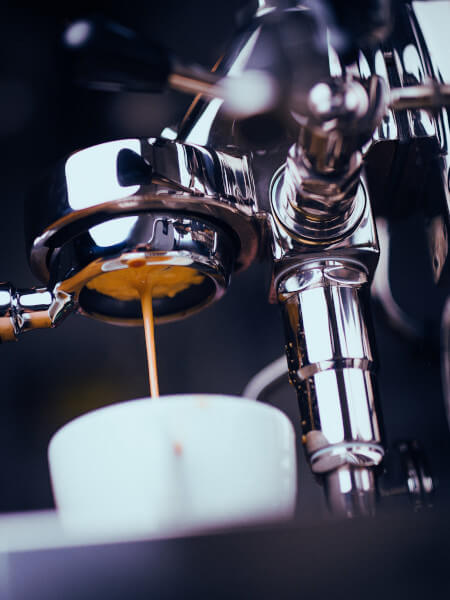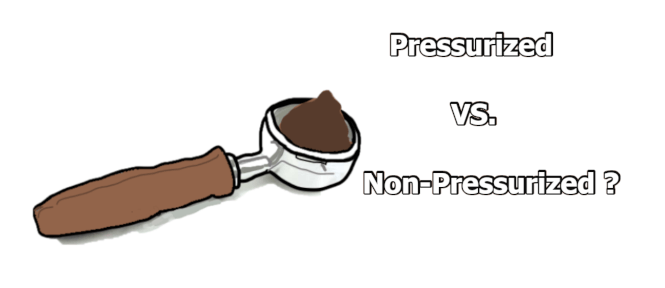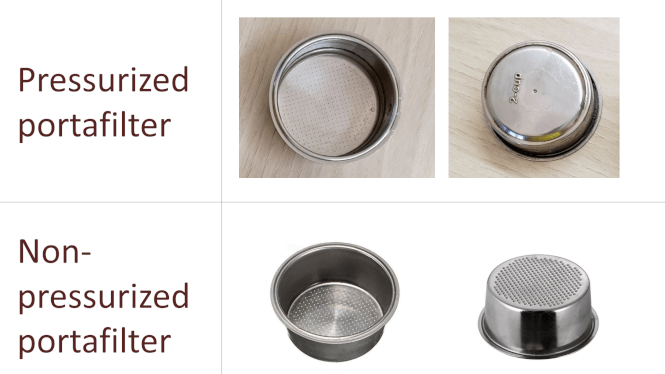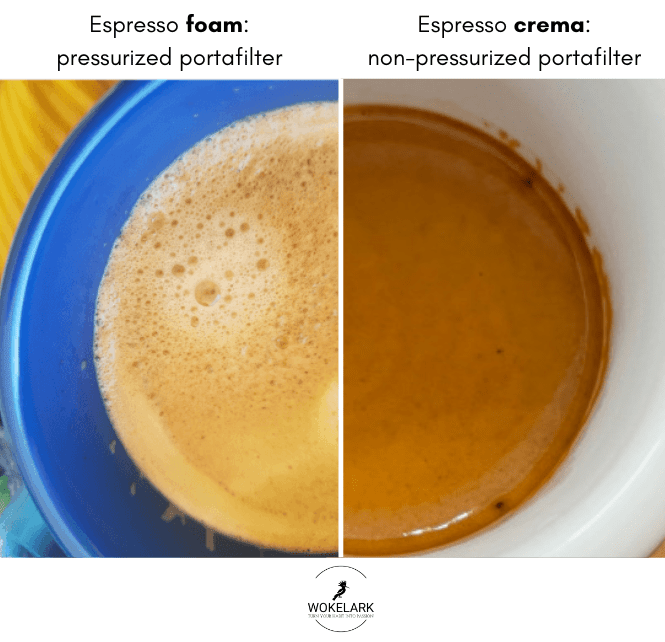Ten-fifteen years back my father and I were looking to buy a high-quality espresso machine that my mother, famous for her exquisite palate and love for coffee, would like.
During our research, I first became aware of the existence of the dual-wall pressurized portafilters and their single-walled ancestors.
If you’re looking for your first espresso machine, I’m pretty sure you’ve stumbled upon those two options.
But which one should you choose to make your coffee with?
Is there a significant difference between the coffee made with a pressurized portafilter and the one made with a non-pressurized basket?
What is the grind size that you should use having one or the other?
Maybe you’ve heard that dual wall filters are bad and don’t make a “real espresso”.
Then what are you having if you’ve been using the pressurized version ever since you’ve had your espresso machine at home, and what difference does it bear compared to a non-pressurized filter?
If you feel like something is missing and you want to master the extraction and the overall taste and quality, it might be good for you to check if the portafilter you’re using is the one that can produce the coffee of your dreams.
So let’s dive in and explain all you need to know.
What Is the Difference When It Comes to Pressurized Versus a Non-pressurized Portafilter?
In order for you to find out which one will suit you best, you need to understand what are their basic characteristics.
Here is the difference between pressurized and non-pressurized portafilters:
In its essence, espresso needs to have a decent extraction of emulsified coffee oils, which can be best achieved through a finer size of the grind.
Non-pressurized portafilters work with such espresso fine grind.
The tamped coffee grounds provide the resistance and serve to build the needed 8-9 bars of pressure in the basket.
This forces gases out of the grounds, and the overall extraction results in a rich-tasting and balanced espresso with great crema, emulsified with coffee proteins and oils.
However, with pressurized portafilters, the grind needs to be coarser because the fine espresso grind blocks the dual-wall basket mechanism and doesn’t allow water pressure to build in and open the tiny valve.
This would choke the coffee machine.
When using pressurized portafilter the coffee is being forced through a small hole which results in aeration, producing faux crema (foam).
For these reasons, the coffee made with pressurized portafilter isn’t as good as the espresso made with a non-pressurized filter basket.
A pressurized basket doesn’t allow for an extraction process that will result in a classic espresso taste and mouthfeel.
Mechanical dissimilarities between the baskets
You can tell the difference between the two filter baskets easily.
With the pressurized portafilter, the coffee goes through two screens.
The internal one looks just like a standard espresso basket with lots of holes spread evenly on it.
This is where you place your coffee grounds.
After the water passes through the grounds, extracting them, it enters the holding area, between the first and the second screen, where the machine pressure builds up and the coffee gets pushed through a tiny hole (sometimes the holes are two).
This is why pressurized portafilters are also called dual-wall filter baskets.
Even without you placing any coffee in the basket, some pressure can build, because of this mechanism.
When 9 bars of pressure are reached the coffee starts pouring down, entering your coffee cup.

Photo of a naked non-pressurized portafilter made by Janko Ferlic from Pexels
Non-pressurized portafilters were the ones put into work when espresso was first made and nowadays – where espresso is properly made.
If you manage to get the hang of using it properly, you will end up with a beautiful cup of full-bodied coffee with a nuanced taste and satisfying intense crema.
But is taking time to get the hang of it really worth it in your case?
Which One Will Suit You Best at Home?
Now that you know the basic differences between the espresso coffee filter baskets we’re currently discussing, and between the coffee they produce, you may quickly jump to the conclusion that you want the single wall filter basket.
After all, we all want to have the best possible espresso at home.
But as I already mentioned, if you want to upgrade to a non-pressurized portafilter you need to take some time to figure out the way to use it.
Not only that:
When brewing with a single wall basket for espresso you also need to make sure you use good quality, freshly roasted beans.
That comes on top of experimenting with the dose, grind, distribution, and tamping.
Whole coffee beans can be considered fresh for only 3 days after opening the valve-sealed bag.
My first barista trainer taught me this.
He also made sure we made espresso with freshly ground beans that have gone through the grinder within the last 3 hours.
He was serious about us making high-quality espresso. He insisted we know that after the third hour post grinding the coffee grounds produce a stale cup because of their contact with the oxygen.
To be fair, with time I learned that if you want to make exceptional espresso, you should grind right before pulling a shot.
I actually start noticing a considerable difference in espresso’s overall quality after leaving the ground beans in the grinder’s container for only 15 minutes.
Furthermore, during the practice exam of my Espresso Acedemy barista training, I had to make sure that I start the espresso extraction within 5 seconds after securing the portafilter to the group head. Leaving the ground beans in the heated portafilter basket for longer would further deteriorate the flavor.
Related Post: How Long do Coffee Beans Last
To perserve the flavor of ground coffee beans at home is best to keep them in an airtight container with a CO2 valve.
It’s essential to also point out that not all grinders can achieve a proper espresso grind.
If you are planning on using a non-pressurized portafilter you have to invest in an adequate grinder that can produce a consistent high-end espresso grind out of your freshly roasted coffee beans.
You will have to invest at least $400 – $500 in a new grinder.
If you ask me all that is totally worth it.
If you appreciate a classy espresso you should be looking at something like this.
I love having total control over the brewing process, knowing that I use high-quality products that are capable of producing a high-quality espresso taste.
Check out this beginner-friendly guide on the best water for coffee to find out more.
I also quite enjoy the process of preparing coffee with the non-pressurized filter basket.
Ever since I got the hang of it I have impressed quite a few of my friends with my espresso-making skills.
They love making fun of how serious I am about coffee making, but in the end, they all enjoy what I’ve prepared.
A dual wall is a great option if you have a lower-end grinder or if you tend to use store-bought pre-ground coffee and you’re satisfied with its taste.
The pressurized portafilter exists to ease the brewing process.
You shouldn’t be that precise with all the variables that non-pressurized portafilters are highly sensitive to.
You will get consistent results with the coffee, even if the level of tamping, the coffee grind, and the dose differ between each brew.
Overall you won’t have to spend as much money and you will get an easier cup of coffee.
And if you don’t mind that with pressurized portafilter you won’t get to have a real espresso by the book.
In comparison to the real espresso, the one you’ll get with the pressurized filter basket will have somewhat stable, but rather airy foam, and a thinner body.
If you’re used to the original taste – you will notice that the result you’ll get isn’t as rich in flavor as you’d expect.
But if that isn’t an issue in your case, you can get a satisfying cup of coffee at home each morning with the dual wall.
And when you feel like spoiling yourself with a high-quality espresso – go to a café and order one.
This way you will enjoy it even more.
Conclusion
I hope I managed to help you out and now you know which type of portafilter is the one for you.
You may decide that the battle of the pressurized versus the non-pressurized one is won by the double-wall filter basket.
However, in time you might want to dive deeper into the world of coffee and upgrade to a higher-end grinder and a single wall filter.
To those that feel the urge to dive in sooner – congratulations!
The single wall portafilter is worth the hassle.
I plan on writing an article to give you a detailed guide on how to use the non-pressurized portafilter to ease your journey as a beginner.
Edit: The article is already written, you can check it out here: How to Pull an Espresso Shot: Full Guide with Photos.
But now let me know what your thoughts are in the comments below.
Which one did you choose and why?




Hello- Bought a Mr Coffee Cafe Barista- and it seems to me that the auto settign for a ‘double shot’ espresso gives a 1 to 8 ratio. The ‘double shot’ basket only takes 10 grams of coffee, brews for 25 seconds or so- and puts out 80 grams of liquid- nice bubbles, but still- it’s bitter- mostly- a few shots I’ve had were a little better but most are bitter (which i don’t actually mind- i like bitter coffee too) but in order to get a 1 to 2 ratio- i have to manually stop the machine at right around 7-8 seconds, and only get about an ounce to ounce 1/2 out which is right around 20 grams.
What am i doing wrong? The 20 second ‘espresso’ i just tried did taste better- but there wasn’t hardly anything there- The grind is very fine- (I’ve tried courser grinds too)
I’m gonna cut the bottom off the “1 shot basket” (like in the link you provided below, to make it single wall basket) as I’ll never use it and give that a try- but my goondess, to get the right 1-2 ratio, I’m gonna have to stop it at 4 seconds brew time? There won’t be nary anything there for espresso. (I could keep making more with fresh basket fills a few times, i know- but kinda time consuming)
I just spent $200 on the Mr Coffeee Cafe Barista, and just today learned about the fact that it’s not a true espresso machine 🙁 Hoping i can salvage it with the basket hack?
Could you also reply in email? I check the email often- so I’ll see that before anything- thanks
Bob
I have the cafe barista too! I love it but I don’t drink espresso that often. Basically, you bought the wrong machine if you just want to drink espresso. But here’s what you do. Buy a 51mm non-pressurized basket off Amazon for the barista. Check that the basket height is the same as the pressurized one. Then get some very fine grind espresso coffee (the finer the better) and pack it super tight (10-20+ lbs pressure) and brew your coffee. You should get something similar, but the barista is really designed for store bought ground coffee…like most Mr. Coffee units. Hope that helps.
Thank you for this, it is a very thorough and easy to understand explanation. This is very helpful as I have been going further and further down the espresso making rabbit hole for a few months now and I am still seeking the perfect cup!
Great explanation! Thank you!
I just received my non pressurised basket and my first coffee ended up with no foam.
I wonder if there is a guideline over the size of the grinded coffee to use. My assumption is I need smaller particles?
Hey Georgios,
I’m sorry for the delayed response.
As I mention in this post, there is a difference between espresso foam and crema. Since you’ve bought a non-pressurized basket, I guess that you’re aiming at pulling a shot with a perfect (or a good enough) crema layer. There may be many reasons why you ended up with a shot that doesn’t have that and it’s completely normal for you to experience such an outcome since you’re a beginner.
Espresso grind is almost as fine as a powder but still coarser than, say, powdered sugar. I’d describe it as superfine beach sand with a powdery texture. The quality of the grinder you use is very important too, as inconsistent grind will lead to channeling, uneven extraction, and lack of crema. You should also be aware that you can’t get perfect crema if you use beans that aren’t fresh. Fresh beans are those that are roasted within the last 14 days. There is a big difference between a shot pulled by using beans that are store-bought and come in a nitrogen-flushed sealed bag, and a shot prepared by using freshly roasted coffee beans from your local roaster. As you might’ve guessed the latter option is always better. You should also make sure that the grounds are evenly distributed throughout the filter basket and that you use a tamper to level out and compact the espresso puck.
With that being said, don’t be afraid to make mistakes. We’ve all learned through trial and error. I’m sure that with time you’ll get to enjoy the best espresso you’ve had at your own home.
I’ve been planning on writing a detailed guide with photos on using a non-pressurized portafilter for a long time now. I hope that I manage to fit it into my schedule as soon as possible. Until then, I hope that you found something useful in my delayed response.
Thanks for being a reader, Georgios, and have a great year!
Amazing article. This solved my question.
I just started serious espresso making recently with a cheap espresso machine(delonghi ecp 35.31) at home. I ordered a single wall filter and I was surprised at the taste of the espresso. Full body taste. (At first the shot was terrible but after I make ground finer and increased the dose, it worked) Thank you so much for your wonderful guide to my coffee journey. Bless you.
From South Korea.
Hey Jinsu,
Thank you for reading my blog and for taking the time to leave this lovely comment. I’m very happy that you found my post helpful.
I’m sure that in time you will become even better at pulling excellent espresso shots with your non-pressurized portafilter.
Good luck and take care!
Vessy.
hola buen dia mas claro ni el agua gracias por la informacion muy completa podrian decirme si esta maquina se puede usar con filtros no presurizados el modelo es DeLonghi EC702 15-Bar-Pump
Hola, chuy
Lo que puedo ver es que DeLonghi no ofrece un filtro que no es presurizado como una pieza de recambio/accesorio con ese modelo (EC702). Aunque eso puede significar que los fabricantes no hayan cumplido con las caracteristicas necessarias para usar un filtro non presurizado con esa maquina, basado en la descripcion del producto yo pienso que se puede usar con un filtro no presurizado.
Pienso que Usted puede comprar un filtro (non-pressurized) universal con un tamaño apropriado. De acuerdo a mi investigacion online yo veo que hay personas que usan esa maquina con un filtro que no es presurizado y tienen exito, pero no tengo experiencia personal.
Recordatorio: no olvide que tiene que usar una amoladora de cafe de buen calidad.
PD: He estudiado español en mi escuela y no lo he practicado en mucho tiempo. Espero que mi respuesta haya sido ùtil.
Saludos!
Hi! Nice article! I have a question though: If my machine is shipped with a pressurized basket, will it accept a non pressurized one? (I own a Magimix Expresso and Filtre).
Hey, Julien!
Please, check out my reply to Mamad in the comment section, as it might be helpful to you too.
As far as I can see the Magimix L’expresso filtre does only come with a pressurized filter. On their website in the spare parts section, they don’t offer a non-pressurized alternative for this machine. Nevertheless, you can measure the diameter of the filter basket (in mm) and look for a single-wall one that would fit properly. You might be able to find something that fits nicely online. Nevertheless, even with proper grind size and consistency, if you replace the portafilter the results might not be as good as you’d like them to be (this is an assumption made by me after taking into consideration the Magimix L’expresso filtre price and the fact that it’s a 2 in 1 machine; I might be wrong, though).
I hope that you found my reply helpful.
Good luck!
Vessy.
This was a great explanation. I really like it, because I had read a lot about the difference, but I couldn’t understand the exact difference. Now, I know 🙂 Thank you
Could you please explain that is there any difference between the process to make steam for a pressurized and a non-pressurized basket. I mean if the difference is just between the basket we could use a non-pressurized basket with any machine by having a suitable grinder?!
Hey Mamad,
I’m sincerely sorry for the late reply.
In theory, if you have a good grinder you can switch your pressurized portafilter with a non-pressurized one that’s suitable for your espresso machine (sizewise). By doing so you would gain more control over the whole process and after a bit of trial and error, you will be able to achieve improvements in the espresso shots you pull. Many people who can’t afford spending much on espresso equipment, tend to replace the filter basket of their budget-friendly machine with a non-pressurized one. Some would even cut the dual-wall filter basket with a Dremel to turn it into a single-wall one (like this guy here). With that being said, while it’s possible to make better shots that way, they won’t be as good as those pulled with a higher quality espresso machine. Higher quality espresso machines are also better at providing consistent results – great, rich espresso, and perfect crema shot after shot (once you get the hang of it).
What’s also worth noting is that some budget-friendly espresso machines (that cost, say, under $100) aren’t intended to be used with non-pressurized filter baskets. Even if you manage to get your hands on a single wall portafilter that fits your machine perfectly, the cheap steam espresso machine will likely overheat the grounds and burn your coffee. Achieving crema is nearly impossible with such a machine; also, the hot water often comes out aggressively out of the spout which causes channeling and uneven extraction no matter the type of portafilter you use. So if you own such a machine and you’re keen on making good espresso at home, I’d recommend getting a second hand Gaggia Classic instead of looking for ways to replace your cheap machine’s pressurized portafilter with a non-pressurized one.
I apologize for the late reply again. I hope that this answer was still useful.
Take care!
Best explanation I’ve found so far. I got a Gaggia pressurized filter ND was confused as to why the crema was so bubbly. Now I know! Thank you very much
You’re welcome, Dev!
I’m glad that I helped you to figure it out.
Take care :))
Good explanation, but that non pressurized picture looks disappointing.
No crema at all.
What photo are you looking at? Looks fine to me .
This was an excellent explanation for those who are confused about the differences. The best I’ve seen it explained. Thank you.
Thanks for your feedback, James! I’m happy that you found my post helpful :))